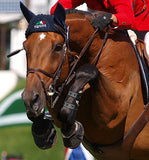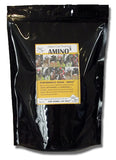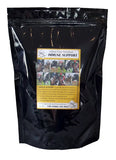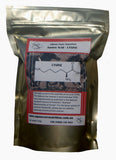Nutrition for athletic recovery
 Your horse has given his all: strained muscle and sinew to give you every last ounce of power and speed. So what can you do to help aid his recovery? The timing and content of his next feed can have a significant impact on recovery time and his ability and willingness to perform.
Your horse has given his all: strained muscle and sinew to give you every last ounce of power and speed. So what can you do to help aid his recovery? The timing and content of his next feed can have a significant impact on recovery time and his ability and willingness to perform.
ENERGY: refilling the tank
The important first step is to replenish the cellular energy stores that have been used up during heavy exercise. If your horse has to compete the following day then the need for this is obvious, but energy is needed for more than just muscle function: cells need fuel for the process of repair and for the immune system to function properly, both important in recovery time and your horse’s ability to fight off infection during this period. If cellular glycogen stores can be replenished within the first hour after heavy exercise, recovery time can be dramatically reduced. Multiple studies have demonstrated that unless intensive efforts are made to provide readily digestible carbohydrates to replenish glycogen stores quickly, equine muscle takes up to 3 DAYS to completely replenish glycogen lost during heavy exercise. An excellent source to use is maltodextrin which is absorbed rapidly and quickly converted into glycogen: up to 110g initially (any more than this and some will escape digestion and end up in the hind gut), followed an hour later by 55g, and repeated again at 2 hours if necessary.
B vitamins are another important part of the energy and recovery equation. They are needed for glucose metabolism (turning our maltodextrin into glycogen) and processing other carbohydrate energy sources as well as protein and fat metabolism. In every horse, adequate B vitamins need to be consumed on a daily basis, as the body does not store them. Horses on low forage/high grain diets in heavy training may not be getting enough from their diet to support output. One study found a dramatic drop in folic acid levels in thoroughbreds in training. B vitamins to consider supplementing are: thiamine, riboflavin, niacin, biotin, folic acid, B12, pyridoxine and pantothenic acid.
PROTEIN: maintaining the machine
Some muscle soreness is an inevitable consequence of hard exercise: muscle is damaged during exercise and it is the process of repair that builds a stronger muscle. However if at all possible we want to preserve muscle mass and avoid muscle pain in our conditioned, competition horse, and help our horse in training adapt to his workload. Ensuring adequate levels of key amino acids (the building blocks of proteins) at the appropriate times can greatly assist in this.
As glycogen levels drop in an exercising horse, branched chain amino acids in muscle may be broken down and used as an energy source. If more protein is broken down than is built then the horse will lose muscle mass. We can avoid this by ensuring the horse has adequate amino acids after hard exercise (but not before, as supplementing branched chain amino acids before exercise can negatively impact speed work). The amino acids in question are leucine, isoleucine and valine: all are essential, which means they have to come from the diet, the horse cannot synthesise them. These are the major amino acid constituents of muscle protein, with leucine being the most important. Leucine regulates protein synthesis in muscle tissue: muscle building will not occur until and unless cellular leucine is returned to a normal level. To put it simply, in order to help your horse recover and repair muscle micro trauma, make sure he has sufficient leucine after exercise. Requirements for these amino acids remain elevated for several days after heavy exercise.
Also ensure your horse is getting sufficient phosphorous, as deficiency interferes with the ability to lay down muscle. Phosphorous depletion has profound effects on skeletal and heart muscle, as well as red blood cells. To ensure adequate phosphorous, make sure the calcium:phosphorous ratio (1.2:1) in your horse’s ration is tightly maintained. A 500kg horse in heavy work needs 29g of phosphorous a day. It is possible to increase levels of phosphocreatine (a molecule that serves as a rapidly mobilizable reserve of high-energy phosphates in skeletal muscle) by supplementing creatine immediately after exercise when muscle levels are at their lowest.
VITAMINS & MINERALS: fighting the good fight
Another consequence of exercise and aerobic energy metabolism are ‘free radicals’, or reactive oxygen species (ROS). The generation of energy is a complex chemical dance that takes place in the mitochondria of the cell. Free radicals are created as part of that process. If left unchecked, free radicals have a negative effect: damaging lipids, proteins and cell DNA. Sufficient free radical damage can actually cause a cell to program its own death. To protect against such damage the body has antioxidant enzyme systems that are strategically positioned to deactivate free radicals as quickly as they are produced, breaking them down into harmless water. Free radical damage can still occur if antioxidant enzyme systems cannot keep up with the rate of generation of free radicals. For the hard working horse the consequences can be muscle soreness from muscle damage and poor performance related to impaired energy generation. You can help protect your horse against this by ensuring adequate levels of the key minerals and vitamins needed for the antioxidant enzyme systems. These include selenium, copper, zinc and Vitamin E. Ensuring your horse has adequate levels of these nutrients before and after heavy work will enable his own body to fight most effectively against free radical damage.
After your horse has given his all, we can step in and give him everything he needs nutritionally to support his recovery. By taking the time to fully understand his nutrient requirements in the hours and days after heavy exercise and competition we can ensure his body has what it needs to repair damage and recover quickly so that you have a happy and willing horse that will want to go out and try for you all over again. But like all things, there is no one easy magic bullet, optimising nutrition for recovery takes knowledge, balance and timing, but don’t you owe your equine partner that investment?
|
RELATED PRODUCTS |
|||
 |
 |
 |
 |
| Amino-3 | Immune Support | Lysine | Omega-3 |